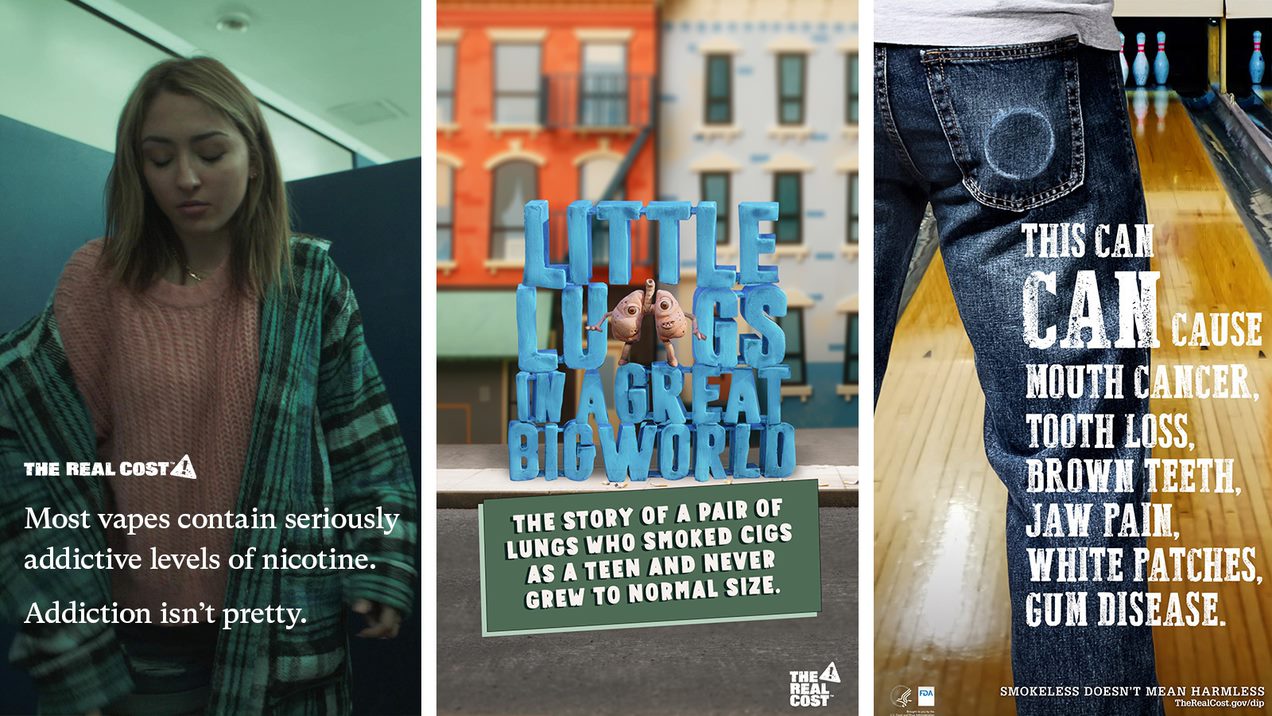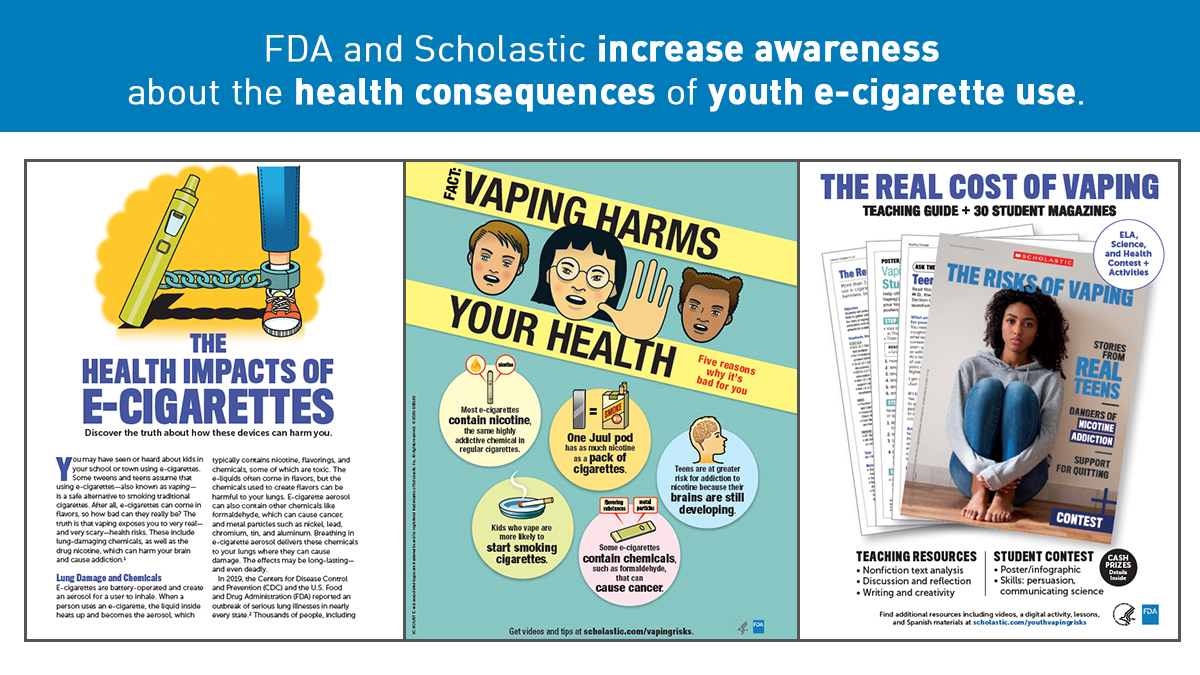The Real Cost Campaign
On this Page:
- Current Public Education Campaigns
- Campaign Resources
- Campaign Ads
- Past Public Education Campaigns
- Awards and Recognition
Current Public Education Campaigns
"The Real Cost” Youth E-Cigarette Prevention Campaign
E-cigarettes are the most commonly used tobacco product among U.S. youth. Today, youth e-cigarette use continues to decline but remains an ongoing public health concern with over 2 million youth still using e-cigarettes1.
Our Goal: Educate youth about the dangers of e-cigarette use. The campaign addresses the “cost-free” mentality in middle and high schoolers with messages that educate youth that using e-cigarettes puts them at risk for addiction and other health consequences.
Campaign Research
How Research Guides Our Campaign
FDA conducts research with teens on an ongoing basis, including focus groups and surveys across the country. Our research, which is diverse in geography, race and ethnicity, gender, age, provides key insights about potential campaign messages and ads.
Our Approach
“The Real Cost” e-cigarette prevention campaign uses a variety of marketing tactics and creative advertising to reach its audience. Advertising and prevention materials are delivered across teen-relevant communication channels, including:
- Television ads
- Online video ads
- Social media
- Media partnerships with youth-focused content, such as Marvel Comics and Rick and Morty
- “The Real Cost” campaign’s youth-focused website
- Posters for high schools nationwide
“The Real Cost” Cigarette Prevention Campaign
FDA’s first tobacco prevention campaign, “The Real Cost,” was launched in 2014. In its first two years, research showed “The Real Cost” prevented up to 587,000 youth ages 11 to 19 from initiating smoking between February 2014 and November 2016, half of whom might have gone on to become established adult smokers.
Our Goal: Educate youth ages 12-17 who are at-risk for smoking cigarettes in the United States about its harmful effects.
Campaign Research
How Research Guides Our Campaign
FDA has conducted several rounds of research with teens, including focus groups, interviews, and surveys across the country. Our research, which is diverse in geography, race and ethnicity, gender, age, informs our campaign messages and ads.
Today, with teen smoking at an all-time low, our research helps us assess and refresh our messaging to ensure we are being effective with an audience that hasn’t been swayed by other prevention messages.
By preventing these kids from becoming established smokers, "The Real Cost" campaign will save more than $53 billion for youth, their families and society at large by reducing smoking-related costs like early loss of life, costly medical care, lost wages, lower productivity, and increased disability.
Our Approach
“The Real Cost” cigarette prevention campaign uses digital marketing tactics and creative advertising to educate the audience on the negative consequences of smoking. Some of these marketing tactics included:
- Digital and streaming video advertising
- Streaming audio advertising
- Social media to engage the audience
- A variety of influencers to extend the campaign’s messaging
Campaign Resources
Quitting Resources for Youth
FDA partners with the National Cancer Institute’s (NCI) Smokefree.gov initiative to provide youth with resources for quitting e-cigarettes. Resources and information on Teen.smokefree.gov are designed specifically for youth audiences by cessation experts. “The Real Cost” campaign connects youth to these resources on social media and various digital platforms (Spotify Pandora, Wattpad, etc.). Some of the quit tools and resources include:
- Online chat with counselors trained to help youth quit
- SmokefreeTXT for Teens and quitSTART App to help quit smoking
- Quit Builder tool to help teens make a personalized quit plan
- Quizzes and Surveys to help teens understand vaping addiction
- Information about nicotine withdrawal and addiction
E-cigarette Prevention Resources for Educators
FDA provides resources to educators, parents, and community leaders to prevent youth e-cigarette use. FDA and Scholastic developed resources for educators to teach youth about the harms of e-cigarettes. These materials are accessible online for free in English and Spanish and are adaptable for remote instruction or independent student work. Materials include:
- Student magazine
- Videos
- Lesson plans
- Activity sheets
- Infographics
- A guide for parents to talk to kids about e-cigarettes
Free Tobacco Education Materials at FDA Tobacco Education Resource Library
Learn more about print materials, web content, and social media posts available for free that help keep communities informed about tobacco-related issues
Campaign Ads
Video
Past Public Education Campaigns
“The Real Cost” Smokeless Tobacco Campaign
In April 2016, FDA launched a new campaign under “The Real Cost” brand to reach rural male youth ages 12-17 who were at risk for smokeless tobacco use.
Our Goal: Prevent and reduce smokeless tobacco use in rural male youth, an audience that was more than twice as likely to use smokeless tobacco as those in urban areas.
“Smokeless doesn’t mean harmless,” the campaign’s central message, motivated rural male youth to reconsider what they think they know about smokeless tobacco use.
This was the first large-scale smokeless prevention campaign designed to reach this audience and was built on extensive research.
Campaign Research
How We Used Research to Develop “The Real Cost” Smokeless Tobacco Campaign
Extensive research with male youth was conducted across the country in rural communities with high rates of smokeless tobacco use. Research included focus groups and in-depth interviews with teens to understand their unique cultural and behavioral characteristics.
From research, we learned:
- Male youth were more likely to initiate smokeless tobacco use if it was offered by a family member or friend.
- “Dip” use is a common form of social bonding during sports and outdoor activities.
- Messages that create negative emotional responses, such as disgust or fear, were compelling and easy to understand for this audience.
- Motivating messages needed to include straightforward facts about the consequences of dipping and depict a story or include an emotional appeal.
- Rural male youth had strong sense of community within their hometown and valued relationships with adult mentors, such as coaches or family members.
Our Approach
The campaign delivered facts about the dangers of using smokeless tobacco in relevant and attention-grabbing ways with a focus on addiction and negative health consequences that was relatable and appealed to the audiences’ identity. Advertising was tailored to the interests of rural male youth (hunting, fishing, sports) in communities with the highest smokeless tobacco rates.
The campaign used a variety of tactics and communication channels that aligned with the audiences’ interests, including:
- Local television and radio
- Outdoor signs
- Digital advertising, such as online videos
- Social media on Instagram and Facebook
- Influencers
- Campaign website
Our Impact
“The Real Cost” Smokeless campaign ended in 2020 and was successful in reaching the target audience and delivering tailored messages that changed the audiences’ beliefs and attitudes. Some key learnings and accomplishments include:
- Older adults, influential dads, coaches, and female peers played an important role in influencing the audience’s behavior – featuring these influential figures in our ads evoked positive feelings and aligned with the audiences’ values.
- Graphic depiction of cosmetic and health consequences grabbed the audience’s attention. For instance, illustrating the long-term effects such as gum disease and jaw removal or developing white patches in the mouth was described as compelling.
- Addiction messages depicting loss of control paired with a negative social consequence, such as dip interfering with teens’ personal goals, were believable and motivating to the audience.
- Social media influencers active in outdoor activities (hunting, fishing, sports) delivered authentic messages, built credibility, and increased audience engagement on social media.
- “The Real Cost” Smokeless Tobacco Prevention Campaign website had over 3.7 million visitors, and the campaign’s social media channels had over 340K monthly social interactions, such as likes, shares, comments, link clicks, and video views.
“The Real Cost” Smokeless Campaign – Making Sure Rural Male Youth Understand that Smokeless Does Not Mean Harmless
- “Don’t Search It” ads peaked teen curiosity by using graphic visuals in ads to show negative health effects from smokeless tobacco and encouraged teens not to search for those consequences. These ads resulted in increased searches of keywords, such as mandibular cancer and white patches, and increased visits to the campaign website.
- Worked with sports coaches in rural communities to share their personal experiences with dip using storytelling through videos on social media.
Campaign Evaluation Highlights
FDA conducted a longitudinal study on the impact of “The Real Cost” Smokeless.
- The campaign was successful in reaching almost 90 percent of the intended rural male youth audience.
- Several beliefs and attitudes on addiction and health consequences, such as “If I use smokeless tobacco, I will damage my body” and “If I use smokeless tobacco, it will shorten my life” changed significantly during the campaign among older boys, ages 14 to 16.
Publications
“The Real Cost” Smokeless Campaign: Changes in Beliefs about Smokeless Tobacco among Rural Boys, a Longitudinal Randomized Controlled Field Trial.
Awards and Recognition
“The Real Cost” E-Cigarette Prevention Campaign
- Effie Awards
- 2021: Bronze Effie in the Disease Awareness and Education category
- 2015: Gold Effie in the Disease Awareness and Education category
- ARF David Ogilvy Awards
- 2021: Gold award for “The Facts about Vaping are Scary Enough” campaign ad
“The Real Cost” Cigarette Prevention Campaign
- Effie Awards
- 2020: Bronze Effie in the Youth Marketing category
- 2017: Bronze Effie in the Youth Marketing category
- 2015: Gold Effie in the Disease Awareness and Education category
- Festival of Media Awards
- 2020: Grand Prix for Campaign of the Year
- 2020: Best Branded Content led by Digital Channels
- 2020: Best Communications Strategy
- 2020: Creative Use of Media
- The One Show Award
- 2020: Merit award at The One Show in the Branded Entertainment Games category
- Power or Purpose Award
- 2020: Power of Purpose for Brand Purpose
- Verizon Media Award
- 2019: Brandblazer for Premium Integrations
- AdWeek
- 2019: Media Plan of the Year Award for Best Use of Branded Content/Entertainment
- Clio Health Award
- 2019: Silver Clio award for Branded Entertainment and Content
- 2017: Bronze Clio award for Visual Effects
- 2017: Silver Spike for Film Craft
- Shorty Award
- 2016: Creative work on Tumblr
“The Real Cost” Smokeless Tobacco Campaign
- Effie Award
- 2017 Bronze: Youth Marketing category
1. Centers for Disease Control and Prevention (CDC). Tobacco product use among middle and high school students – United States, 2011-2015. Morbidity and Mortality Weekly Report. 2016; 65(14):361-367.
2. Gentzke AS, Wang TW, Jamal A, et al. Tobacco Product Use Among Middle and High School Students — United States, 2020. MMWR Morb Mortal Wkly Rep 2020;69:1881–1888.


